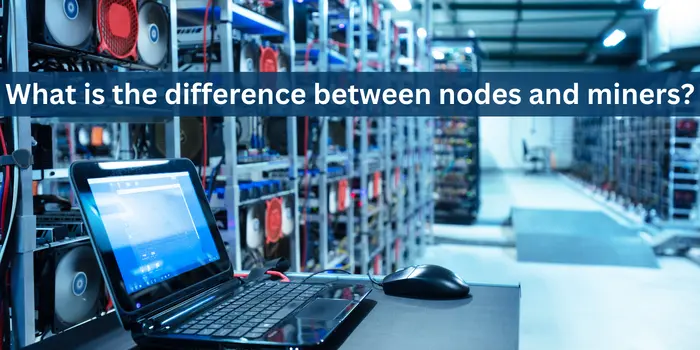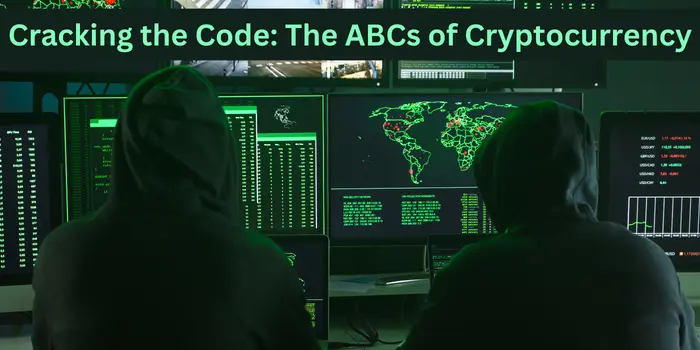
In the captivating realm of cryptocurrencies, nodes are like meticulous archivists, curating and verifying transaction records, while miners embody treasure hunters, unlocking intricate puzzles to expand the blockchain and bagging digital coins as their spoils.
To truly decipher the enigma of cryptocurrency operations, delving into the crucial roles of nodes and miners is indispensable.
Let's embark on this intriguing journey to explore the unique functions of crypto nodes and miners.
Nodes in the world of cryptocurrency serve as digital checkers, verifying transactions and preserving the history of those transactions on the blockchain ledger. On the flip side, miners are the powerhouse workers, leveraging advanced computing power to confirm transactions and bring new digital coins into existence. Together, both nodes and miners create a solid foundation for decentralized and secure transactions within the cryptocurrency network.

Cryptocurrency, in its simplest form, is akin to digital cash. Imagine having an invisible purse or wallet that nobody else can see or touch, in which you carry a unique form of money that's only accessible and manageable via the internet.
Now, these digital currencies aren't under the control of banks or governments. Picture them as rebellious mavericks - decentralized and operating on their own rules. Their activities aren't central to a specific location, nor do they have a governing body to oversee their affairs.
Moreover, these digital currencies kick traditional banking intermediaries to the curb. This allows anyone, no matter where they are on the globe, to send or receive money directly without the need for a bank. Instead of tangible notes and coins, transactions are recorded as digital entries in an online database. This record-keeping system is the blockchain - a transparent, public logbook of all transactions.
Cryptocurrency itself is safeguarded in what we call digital wallets. These are comparable to your physical wallet but are designed to store, send, and receive digital currencies safely.
The term 'cryptocurrency' is derived from 'cryptography' - the art of writing or solving codes. In the context of cryptocurrencies, cryptography secures transactions and controls the creation of new coins, ensuring that your digital money transfers from one wallet to another safely and securely.
Bitcoin, the pioneer of the cryptocurrency world, emerged in 2009. Since then, we've seen the birth of numerous other cryptocurrencies, known as 'altcoins.' Ethereum, for instance, has made waves by providing a platform for building decentralized applications. Litecoin, another popular altcoin, boasts a quicker transaction speed and a larger transaction capacity compared to Bitcoin. Ripple stands out as it cooperates with traditional financial institutions, straddling the line between being a cryptocurrency and a technology for financial systems.
Protecting your digital currencies from unscrupulous actors and technical glitches is vital, and that's where crypto wallets come in. Your digital coins are stashed away in these wallets that could either be tangible devices or digital applications, with the sole purpose of safeguarding your private keys - extremely intricate passwords, in layman's terms. Some trading platforms, known as exchanges, provide wallet services. However, there may be instances where you'll need to acquire one separately. The online or 'hot' wallets ensure your keys are readily accessible, while offline or 'cold' wallets provide additional security by storing your keys off the net.

Imagine blockchain as an ultra-secure, widely accessible online journal that records every entry in real time for everyone to see. Its buzzword status can make it appear intimidating, but let's simplify it.
At its core, blockchain is a technology that safely facilitates the sharing of information. Think of it as an extensive, virtual ledger that securely records data and transactions. The unique aspect of this technology is that it's not maintained by a single entity but updated by a network of participants, known as nodes. These participants are rewarded with digital tokens or currency for their contribution to keeping the blockchain updated. This participatory setup is why blockchain is also labeled distributed ledger technology (DLT).
The charm of blockchain lies in its features. First, it ensures security and authenticity using a system of public and private keys to verify identities. Second, it serves as a digital documentation tool that records transactions on the Internet. Finally, it offers flexibility, existing in both public networks, open to anyone (like Bitcoin's blockchain), and private networks, where access is restricted to authorized individuals (like in certain banks). There are also consortium and hybrid blockchains that incorporate elements from both public and private networks.
Blockchain isn't just the backbone of cryptocurrencies. It has a host of applications beyond this. It can create unalterable records, monitor transactions in real time, and even support 'smart contracts' that automatically trigger transactions once specific conditions are met. This incredible tool enhances data sharing, encourages collaboration, and can address numerous problems across various sectors.
However, like every technology, blockchain isn't without its potential drawbacks. The jury is still out on its value for businesses, its capacity to scale, and how it stacks up against competing technologies. It's important to remember that while the blockchain itself is secure, its users and the data they input must also be trustworthy. Crafty hackers might try to exploit the system, like attempting to control most of the network's nodes, which could result in fraudulent transactions. To guarantee blockchain's future success, it's crucial to tackle concerns surrounding scalability, standardization, and security.
If you've dipped your toes into the realm of digital currencies or cryptocurrencies, you've likely stumbled upon the term "crypto node." Think of a crypto node as a diligent accountant in the vast, complex world of cryptocurrency. These nodes, essentially computers, latch onto a cryptocurrency network, facilitating its operations by validating and disseminating transactions across the network. They also maintain a comprehensive copy of the entire blockchain, which again, is akin to a digital ledger, containing all the transactions. In the Bitcoin world, for instance, the 'full nodes' act as the workhorses of the network.
Picture nodes as checkpoints within a sprawling network. In the cryptocurrency landscape, a node represents a computer linked to a cryptocurrency network, performing tasks like processing and sharing information. When a transaction occurs, nodes receive the details, verify and document them, then relay the information to other nodes. Through this, they ensure the blockchain remains trustworthy and precise.
The roles and responsibilities of nodes vary, shaping their classification. Full nodes are the record keepers, storing every transaction on the blockchain. On the other hand, lightweight nodes handle a lighter load, only needing to download the headers of blocks for transaction verification, thereby requiring less storage space.
Operating a node comes with a suite of benefits. It enhances the network's security, maintains decentralization, and offers control over transactions while presenting a comprehensive record of all transactions. Plus, depending on the network, running a node might present rewards like transaction fees, token rewards, or even voting rights in some instances.
To get a node up and running, you'll need some hardware equipment, a stable internet connection, and the appropriate software aligned with the specific blockchain network. A basic comprehension of blockchain technology will also prove helpful in setting up and troubleshooting any issues.
However, it's crucial to remember that running a node isn't a walk in the park. It demands substantial resources, tackling technical glitches, managing security risks, and handling potential network instability. Furthermore, there are threats to consider when running a node. Your node could fall prey to harmful software attacks, DDoS attacks (which inundate your system with excessive traffic), Sybil attacks (where a single person controls multiple nodes), and chain reorganization attacks. These vulnerabilities could potentially compromise the security and stability of the node and result in financial loss.
A crypto miner is similar to a modern-day gold digger, except their gold lies in the realm of digital currency or cryptocurrency. These miners quarry the digital landscape through a process called mining, which essentially involves verifying and recording new crypto transactions onto the blockchain.
Think of mining as a high-stakes math contest, where the problems to be solved are highly complex transactions that need verification. Crypto miners compete against each other to be the first to crack these math puzzles, and the victor gets a share of the freshly minted cryptocurrency as their trophy. This competitive framework helps maintain the blockchain's security and draws miners into the fray.
So when mining for Bitcoin, miners match up new transactions against the Bitcoin network, solving intricate coded puzzles to append blocks of transactions onto the blockchain's decentralized record. Now, this isn't a job for your everyday computer—it requires specialized, high-powered machinery with superior computing abilities. Now, depending on what equipment the miner chooses, the cost of mining Bitcoin can fluctuate dramatically. In return for their digital sweat and toil, miners are compensated with brand new Bitcoins, unleashed into the digital ether.
The process for mining other cryptocurrencies is similar to Bitcoin as well. The creation of new digital coins still involves miners cracking complex riddles, scrutinizing transactions on a blockchain network, and appending them to a communal record, all in exchange for new crypto coins.
Crypto nodes, integral cogs in the machine of a cryptocurrency network, come in various flavors, each playing a unique part. They join forces to keep the network secure and dependable. When developers put together a blockchain platform, they have to consider how many nodes they need and the specific roles they'll play.
The most vital player in a decentralized network is the full node. Picture it as a librarian who is responsible for keeping the entire history of transactions on the blockchain. Full nodes manage the synchronization, storage, duplication, and distribution of data, and they validate new transaction blocks. By consistently applying the rules, they ensure the database remains trustworthy. Full nodes can further branch out into pruned and archival nodes.
Pruned full nodes, constrained by storage, download the entire blockchain upon setup, but then toss out older blocks, retaining only the most recent data. This method values efficient storage over preserving the entire transaction history.
On the other hand, archival full nodes are like historians; they store every detail of the blockchain, starting from the first block, also known as the Genesis block. Within this category, we find different types of nodes, including authority nodes, miner nodes, staking nodes, and master nodes.
Authority nodes serve as elected officials in private or partially centralized blockchains. They control who can enter the blockchain network. Miner nodes, key players in consensus models like Proof of Work, verify transactions by solving complicated math problems, often in groups, and receive new tokens as rewards for their efforts.
Staking nodes are like investors; they validate transactions in blockchains that use the Proof of Stake model. They lock up a certain amount of tokens, and based on specific criteria, they get the opportunity to process and record transactions.
Master nodes are like full nodes that validate transactions and keep records but without adding new blocks to the chain. They may have additional responsibilities, depending on their role within the network.
Light nodes, also known as Simplified Payment Verification (SPV) nodes, are built for swift transaction processing. They store only essential data and rely on full nodes for comprehensive blockchain information.
Lightning nodes act as traffic controllers, dealing with network congestion problems. They manage off-chain transactions through separate channels and later add the processed transactions to the main blockchain. This technique allows for instant, low-cost exchanges while reducing network burden.
Finally, there are the rare super nodes, created for specialized tasks, like implementing protocol changes or maintaining network protocols.
Cryptocurrency transactions and the functioning of blockchain networks heavily rely on the hard work of miners and nodes. Let's say, for instance, we're talking about Bitcoin. Now again, we’ll equate miners to prospectors during a gold rush, solving complex mathematical puzzles to validate transactions and create new bitcoins. This task demands high-powered computers and a significant amount of energy. When miners strike gold (or in this case, Bitcoin), they're rewarded with a portion of the new crypto. However, mining isn't a casual weekend hobby. It's intricate and can be expensive, putting it out of reach for many.
On the other side of the equation, nodes are like the town's law enforcement, maintaining order in the blockchain networks. They possess a full copy of the town records (or the blockchain ledger), and they verify transactions. When someone initiates a transaction, it's like they've set off a flare that every node in the network can see. Full nodes independently investigate each transaction to ensure its legitimacy. They make sure the person has the funds they're trying to send and that they're abiding by the town's rules (or the protocol). Once a full node validates a transaction, it's added to its copy of the blockchain ledger.
Nodes also communicate within a network of peers to ensure they're all singing from the same hymn sheet. They ensure everyone has the latest edition of the blockchain. With nodes being spread out, the blockchain network remains decentralized and accessible. Nodes are also the town gossips that find and expose any mistakes or invalid transactions, making it difficult for fraudsters to manipulate the blockchain.
Miner nodes have a special role - they add new blocks to the blockchain. These miners solve tough puzzles to find a golden ticket, the right hash value, which allows them to craft new blocks. These blocks undergo an inspection by full nodes before they're added to the blockchain. Mining also involves a dynamic difficulty level, keeping the pace of new block creation steady.
Finally, while mining mainly generates new coins and guards the network, nodes help authenticate and confirm transactions. They work in harmony to keep the cryptocurrency world running smoothly.
Cryptocurrency runs on a unique system where nodes act like digital detectives, scrutinizing and relaying transactions, while miners flex their computer muscles to validate these transactions and create shiny new digital coins. Nodes keep the blockchain as honest as a boy scout and as clear as a summer's day, while miners ensure the network's steady rhythm and craft new digital money. Together, this industrious team of miners and nodes are the unsung heroes of the cryptocurrency realm, ensuring smooth and swift transactions in a network where everyone's on a level playing field.